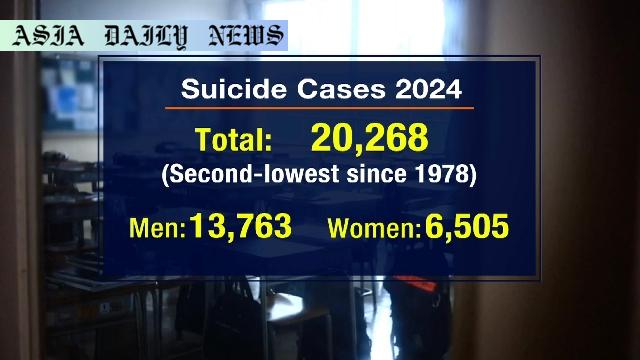Suicides among minors: In 2024, suicides by minors in Japan reached an unprecedented high, driven by school, health, and family issues.
Suicides among minors in Japan hit a record 527 in 2024, exceeding the previous peak of 514 in 2022.
High school students made up nearly 70% of the total youth suicides, with numbers increasing among junior and senior high school girls.
Major contributing factors included school-related stress, depression, and familial discord.
The Japanese health ministry is analyzing the data and collaborating with organizations to address the crisis.
Support services like the Yorisoi Hotline are being emphasized for those in need.

Introduction of the Crisis
The number of suicides among minors in Japan reached an all-time high in 2024, highlighting a troubling trend amidst otherwise declining total national suicide rates. According to data released by Japan’s health and welfare ministry, 527 minors took their own lives last year, surpassing the prior record of 514 set in 2022. Alarmingly, suicides among high school students contributed to nearly 70% of this figure, signaling a deep-rooted crisis among the country’s youth.
Breaking Down the Statistics
In 2024, the total number of suicides in Japan fell to second-lowest levels on record, standing at 20,268 individuals. This marked a 1,569 decrease from 2023. However, the striking disparity between the decline in overall suicides and the concurrent spike in youth suicides draws significant concern. Among those minors, 349 were high school students, 163 were junior high school students, and 15 were elementary school students. Notably, suicides among junior and senior high school girls saw an unsettling rise in 2024.
Factors Contributing to the Crisis
A complex interplay of school-related stress, mental health challenges, and family discord has been identified as primary drivers behind the rise in youth suicides. Many minors faced pressure from academic failures, uncertainty about their future, and strained relationships with family members. Increasing cases of depression and other health struggles further compounded their emotional burdens. These factors collectively underscore the urgent need for intervention and mental health support mechanisms.
Government and Social Response
Recognizing the gravity of the issue, Japan’s health ministry is committed to delving deeper into this crisis. Ministry officials expressed profound concerns over the record-breaking statistics, pledging to work closely with civic organisations, schools, and mental health groups to reverse the trend. Additionally, the ministry is emphasizing awareness regarding counseling services such as the Yorisoi Hotline. Although promising, these initiatives underscore the importance of sustained and collaborative approaches to curb youth suicides effectively.
The Role of Schools and Families
Schools and families play critical roles in addressing this crisis. Academic institutions must foster an encouraging environment that minimizes undue pressure on students while actively identifying those struggling with stress. Simultaneously, families must strive to build open communication channels with children for understanding their challenges and offering timely emotional support. Counseling and mental health resources should also be made readily accessible to both students and parents.
Addressing the Broader Societal Challenges
The record number of suicides among minors also sheds light on broader societal issues in Japan, such as stigmas surrounding mental health and seeking help. Eliminating these cultural barriers and normalizing mental health conversations are critical for creating a society where young individuals feel safe to express their vulnerabilities without fear of judgment.
Conclusion
The sharp rise in suicides among minors in Japan serves as a painful reminder of the challenges confronting today’s youth. It is imperative to address these pressing issues collaboratively, engaging government, community organisations, schools, and families. Support hotlines and mental health resources must be promoted not as a sign of weakness but as essential tools for well-being. A united, compassionate response is vital to ensure a brighter, safer future for younger generations.
Commentary
A Disturbing Trend
The record-breaking rise in youth suicides in Japan is a deeply distressing development that calls for urgent attention. As we analyze these statistics, it is impossible to ignore the tragic implications of a system that, while reducing adult suicides, has failed to provide adequate support for its youngest and most vulnerable members. These numbers reflect not just personal struggles but also systemic shortcomings in schools, households, and society at large.
The Weight of Expectations
The pressure faced by Japanese students to excel in academics, secure a promising future, and conform to societal expectations can feel insurmountable. With nearly 70% of youth suicides stemming from high school students, the alarming consequences of these pressures are clear. Schools must reevaluate their academic structures to foster well-being rather than becoming sources of overwhelming anxiety.
The Need for Collective Action
This issue cannot be addressed by government alone; it requires an all-encompassing effort. Families, schools, and communities must unite to create safe spaces for children to express themselves openly and without fear. Parents should be encouraged to engage in honest conversations with their children, while educators and administrators need to proactively identify struggling students. Meanwhile, cultural stigmas surrounding mental health need to be actively dismantled, allowing young people to seek help without shame.
Hopes for the Future
While the statistics are sobering, they also present an opportunity to spark meaningful change. The collaborative efforts of the Japanese government, schools, families, and communities offer hope for a future where every child feels supported and valued. Addressing this crisis is not just about reducing numbers; it is about saving lives and building a nurturing environment where no child feels left behind.


